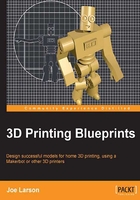
About the Reviewers
Henry Garner started 3D printing in 2010 after buying a MakerBot Cupcake CNC kit as a present for himself. Then a professional software developer with no 3D modeling skills, the obvious next step was to learn the printer's wire protocol and control the print head directly with his own code. The result was the open source Ruby library called Cupcake and many tangled knots of extruded plastic.
It was whilst studying for a Fine Art degree years earlier that he first became interested in programming as a means to create interactive installations and reactive sculptures. The combination of technology and tangible objects remains his passion, and he thinks 3D printing offers a fantastic new way to bring ideas out of the confines of a computer screen into the physical world.
Henry is now Chief Technologist at Likely, a big data analytics company based in the heart of East London's Tech City. When not working, he is often to be found at his art studio by the Tate Modern, floor still littered with extruded plastic tumbleweed.
You can follow him on Twitter at @henrygarner.
Andrew Mazzotta started his career in finance with an MBA. After recently traveling the world, 70 countries in three years, he changed his career for engineering and is now working on three degrees in mechanical engineering, electrical engineering, and computer science. He is currently (August 2013) building RepRaps in Albania for undeveloped areas. The project is in collaboration with Printers for Peace.
He started www.3dhacker.com, a free site dedicated to 3D printing. Members can showcase 3D printers, extruders, printer upgrades, STL model designs, software, printing tutorials, and so on. Additionally, there is a forum for members to support their products/services and a blogging platform for all members to use as well.
Thomas P. McDunn is an engineer and tinkerer and finds 3D printing fuels an ever growing list of projects and experiments. Though formally trained in Mechanical Engineering, receiving a Bachelor's and a Master's Degree from University of Wisconsin-Madison, his interest in computers pulled him on the fence between Mechanical and Electrical Engineering. He constructed his own microcomputer for home experimenting and cut his teeth on electromechanical applications of microprocessors at a time when memory was expensive and code had to be small, not only for memory considerations but for execution speed and hand coding sake. Applying knowledge of mechanical and electrical systems with servo control theory he developed a career in motion control in the Machine Tool Industry and was granted a patent in 1992 for a microprocessor-based transfer line control. He experimented with robotics with a Hero 2000 robot and worked briefly in the industrial robotics industry. Thomas enjoys education and has developed many hands-on curricula for quick immersion of technical concepts. More recently, Thomas has applied his managerial and marketing experience and consults with small businesses in leveraging social media as a marketing tool. Frustrated with the hodge-podge of image sizes used in social media he self-published a book, "72 Pixels" that details the image size requirements of the most popular social media applications. Spurred by an episode of "The Shark Tank", he started a blog to pass along lessons learned in inventor and investor relations. Thomas spends a lot of time online and is enamored with the growth and accomplishments of open source projects.
The open source movement has paved the way for many innovations and more to come. Thomas studies open source applications in a wide arena including Arduino, GIMP, Inkscape, REPRAP, and Drones to name a few. Thomas has experience of many types of 3D printing and rapid prototyping models, setting up a design, and prototyping bureau including SLA, SLS, FDM, Zprint, and PolyJet machines. He has a Makerbot and has recently added a Rostock Max to his personal 3D printer arsenal. Thomas is constantly on the lookout for world changing applications of 3D printing technology. He recently registered with Robohand, a website and organization that makes affordable prosthetics available for children who are born without fingers using 3D printing technology. He catalogs his personal printing projects at www.tpmtech.biz/Makerbot.
Erwin Ried has been enjoying computers and electronics since the age of seven, when he first received his Atari 800 XE. Playing with the buggy coding examples from the Atari booklet always sparked something special in his mind; the idea of governing the machine.
In 2009, HP and Microsoft chose his website as one of the top 50 world best blogs in the HP Magic Giveaway. Later in 2011, LG electronics selected his invention SinStandby as the best green energy related solution for "Casa Eficiente del Siglo XXI".
Now, he is a Computer Civil Engineer (Bachelor) from Chile who loves any kind of challenge including electronics, mechanics, and coding in particular when they involve 3D Printing, electronics, robotics, automation, games and/or programming.